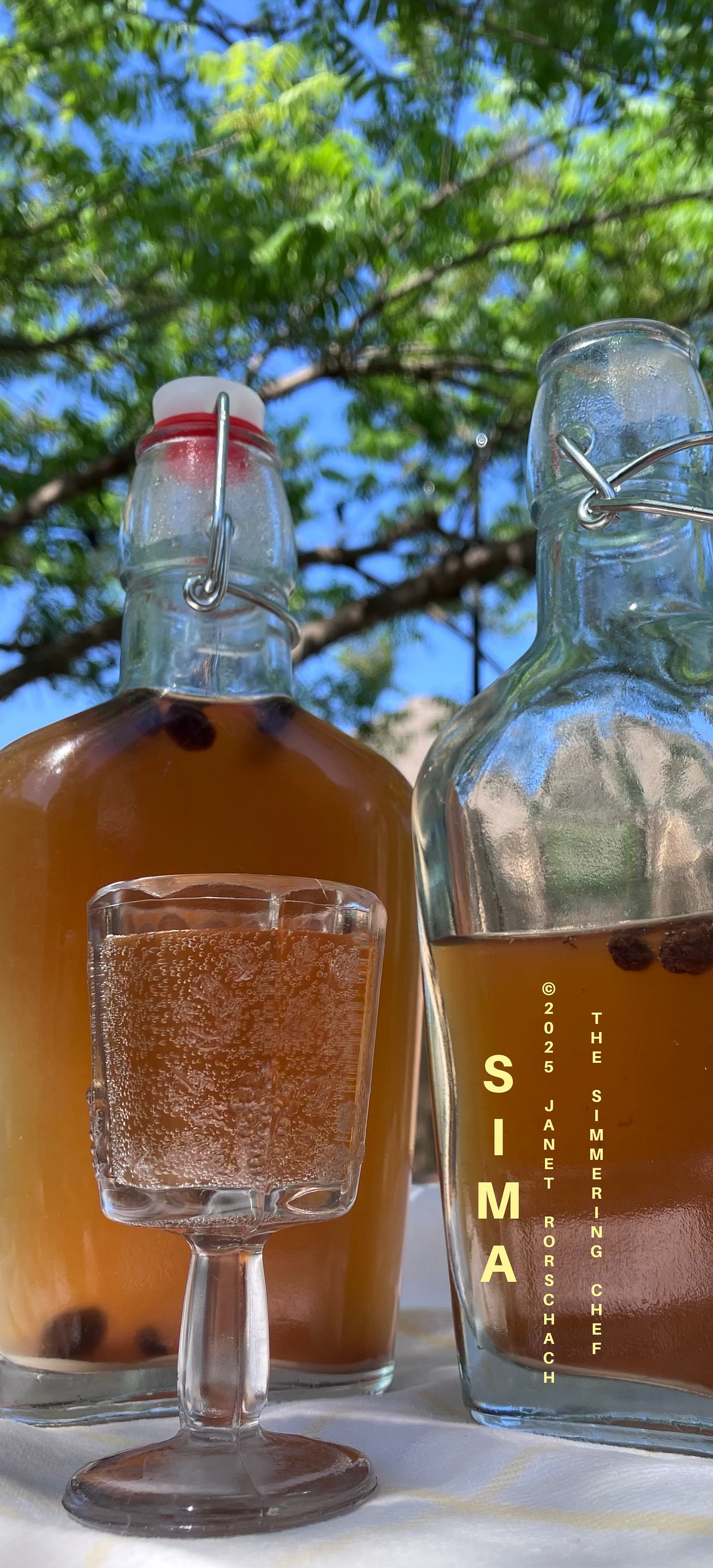“BOOM!” The burst of shattering glass jettisoned my reclining body up from the couch and into the kitchen to find that one of my delicious bottles of Sima—Finnish Fermented Lemonade—had exploded, dripping a sticky mess upon counter, black splashes, and floor. I’m still finding shards of glass as far away as the other side of the room, but that boom saved the other bottles!
Enough said about that. May Day is around the corner, and in Finland, this mead is used to toast in long and lazy summers. It is very refreshing, only slightly alcoholic, and wonderfully fizzy. If you want easy access to fermenting your own foods, here’s your gateway.
NOTES:
What is a mead, you ask? Usually, it’s a type of alcohol made by fermenting honey, yeast, and water. Fruits and spices may be added for additional flavors. The typical alcohol content range is 3.5 to 20 percent. The lower alcohol content beverages are typically called hydromels, but that word lacks the romanticism that the word "mead" conjures. "Barman! Bring me a hydromel at once!"
You can make this with just white sugar for a pale yellow mead, but the brown sugar adds nice caramel notes to the beverage. Do use organic sugar; it helps with the fermentation process.
Use less lemons for a sweeter beverage; use more lemons for a tarter version.
You may use baker’s yeast or dry yeast instead of the champagne yeast. Each one gives a different flavor to this mead. I prefer the flavor of the champagne yeast to the others. I want my bread to taste like bread and my alcohol to taste like alcohol. Bread-flavored drinks are rather blah. I know this because we made wine in high school biology; it was the foulest thing I had ever had up to that point in my innocent life. No need to question what we were doing learning how to make wine in school. It was a religious school, and wine and beer making were part of the curriculum. We might not have become monks and nuns (mainly because it was an Episcopalian school), but we understood how to be ones. It’s a wise person who takes with them the best their education has to offer.
SIMA - FINNISH FERMENTED LEMONADE
INGREDIENTS
11 cups/2¾ liters water
4 - 6 lemons
¾ cups/150 grams organic white sugar
¾ cups/135 grams organic brown sugar
⅛ teaspoon champagne yeast
raisins (optional)
METHOD
PREPARING THE WORT
The night before, measure out the water into a pan and let it sit overnight so the chlorination dissipates.
Peel the skin (the yellow part only) into a non-reactive bowl, such as heat-safe glass or ceramic.
Cut away the pith (the white part) and discard. (The pith and seeds will make the mead bitter.)
Slice the lemon flesh and remove the seeds. Place the lemon flesh into the bowl with the peels.
Add the sugar to the lemon peels and flesh.
Bring the water to a boil.
Pour the boiling liquid over the sugar, lemon peels, and lemon flesh, and stir to help the sugar dissolve.
Cool the lemon liquid down until it’s lukewarm to the touch. You are aiming for slightly warmer than body temperature, ~105°F.
Reconstitute the yeast in 1 Tablespoon of lukewarm water and wait five minutes. (When it's ready to use, it should look nice and bubbly.)
Stir the yeast into the lemon mixture.
PRIMARY FERMENTATION
Cover with some cheesecloth and rest on the counter for 24 hours.
BOTTLE FERMENTATION
Strain the liquid through a sieve into another bowl, and discard the lemon peels and flesh.
If using, add a few raisins to your bottles or jars. These help you see that your fermentation is active and producing carbon dioxide, but if you hate raisins—I see you, Brother Bob!—simply don’t use.
Close your bottles and let the mixture sit on the counter for 12 hours. Now, here’s the thing: Keep an eye on them. If your kitchen is warm—like mine was yesterday—the carbon dioxide builds up faster. You may have to do a quick burp of all the bottles to allow the gas to escape, or you will have a BOOM! too.
Keep fermenting for twelve hours to get a lovely, bubbly concoction, but remember to burp the bottles or jars every few hours to alleviate the gas buildup.
Taste it. If you want it to be more fizzy, allow it to ferment for another twelve hours, but keep quickly releasing pressure every once in a while to prevent explosions.
Once the raisons have risen to the top, refrigerate the bottles.
Refrigerate for at least 24 hours before serving. When you open the bottle, it's best to do it over the sink. The carbon dioxide buildup inside the bottle is similar to that of a shaken soda. Remember what happens when you shake a can of soda? Well, the same can happen here.
ADDITIONAL NOTES:
WORT: A sweet infusion, usually made from grains and ground malt, before starting the fermenting process.
PRIMARY FERMENTATION: This is a biological process where sugars are converted into energy. The by-products are ethanol and carbon dioxide. When this is used in making alcohol, it is known as alcohol fermentation, which is what we are doing above.
BOTTLE FERMENTATION: This additional step allows the mead to get very fizzy.
REFRIGERATION: Refrigeration stops the fermentation process.
PUPDATE:
Sadie is mending well. She had her 8-week X-ray to see how the bone is healing and the vet is pleased. Walks and massages are scheduled for another eight weeks. What a life!
Freddy got diagnosed with Cognitive Canine Decline, and his arthritis has really slowed him down. He will stand in front of the black cabinets waiting for me to give him a treat because he thinks those cabinets are me. Bless his soul. We bought him a stroller so he can enjoy the long walks without having to remember how to move his painful legs.
With those two, my life is less about cooking right now. If I post once a month, that will be pushing it, but I’ll do my best. Enjoy the spring! ~Janet













Share this post